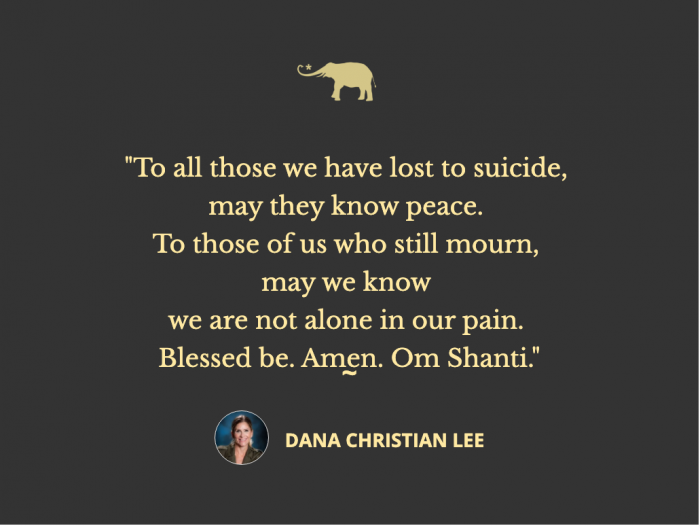Suicide is an important issue near and dear to my own heart.
My life and the lives of my own children have been profoundly impacted by the sudden loss of loved ones that we did not even realize were struggling. Of all ages and stages, my family has lost people close to us.
I am not and will never be okay with preventable loss of life.
Mental health and wellness is too important and relevant a topic to not discuss given its heavy, almost taboo nature. Due to the stigma that can be associated with mental health struggles people often keep pain quiet, in the privacy of their own minds and hearts. If you’ve ever had this experience you know how isolating, lonely, and almost unbearable it can become.
How can we help ourselves and/or others who we know and love?
1. Know the signs
There are three broad categories we can look to for guidance in being able to see more clearly the signs of mental health challenges in adults and adolescents: behavioral, physical, and psychological. Be aware that not all symptoms in isolation are a mental health issue or crisis. The rule of thumb is if challenges persist for two weeks, seek professional help.
Behavioral
~
Best way to to keep your core pelvic and org@sm muscles strong and resilient? Here’s the coveted apparatus that makes this possible >>
~
>> Confusion, difficulty concentrating
>> Inability to carry out daily tasks
>> Quitting/lack of interest in favorite hobby/sport
>> Avoiding social interaction
>> Overuse of substances (drugs or alcohol)
>> Cry frequently for no reason
>> Neglect responsibilities
>> Loss/lack of motivation
>> Inability to perceive changes in one’s own feelings, behavior or personality (”lack of insight” or anosognosia)
>> Change in sleep habits—can’t sleep or sleep consistently throughout the night
Physical
>> Lack of hygiene, personal appearance awareness
>> Fatigue, lack of energy
>> Overeating or loss of appetite
>> Weight loss or gain
>> Headaches
>> Unexplained aches or pains
Psychological
>> Extreme mood shifts
>> Acting out, aggressive, quick to anger
>> Heightened sadness, guilt, indecisiveness
>> Lack of emotional responsiveness
>> Frequent self-criticism
>> Hopelessness, loneliness
>> Thoughts of death or suicide
2. Reach out
Connection is a key preventive factor in suicide prevention. Letting people know you are there for them via phone call, text, or in-person goes a long way for someone in pain. Simply letting them know they are seen and that you care can be just the necessary boost to combat a low sense of belonging. The powerful practice of being present and simply listening can offer a person a moment of calm and healing.
3. Ask others if they are okay
A phone call or visit are great ways to support people when they struggle. However, asking important questions is integral.
“Are you okay today?” “How do you hurt?” “How can I help?” “Are you thinking of hurting yourself?”
4. Keep them safe
If you believe yourself/another to be at risk of harm, mitigate this by establishing immediate safety. Call for the help of a trained professional or use the national suicide hotline for support. It’s open 24 hours.
National Suicide Prevention Lifeline at 1-800-273-8255 or call 911.
5. Work on our own mental wellness each day/check-in on ourselves
This is important not only for you, it is also a model of mindful living for those around you. Take time each day to nourish your body, mind, and spirit to enhance your overall well-being.
Here are some ideas to help support us in our daily lives:
>> Moving with yoga, hiking, sports, or whatever helps you feel more deeply into your body
>> Get outside for some Vitamin D
>> Journaling
>> Gratitude practice—write a thank you note, send a text, keep a gratitude jar.
>> Getting plenty of sleep
>> Eating healthy, nourishing food
>> Staying hydrated
>> Avoiding/limiting alcohol, drugs, caffeine, sugar
>> Limiting screen time/social media
>> Connecting with others/be sociable
>> Performing acts of kindness/service
Parents, please also be aware that mental health issues are not just for adolescent years and beyond.
Issues are known to arise in young children as well. Since children are still navigating how to identify and talk about thoughts and emotions, the most obvious symptoms are behavioral. Children’s symptoms may include the following:
>> Persistent sadness, two or more weeks
>> Changes in school performance
>> Avoiding/missing school
>> Drastic changes in mood, behavior, or personality
>> Excessive worry or anxiety and fighting bedtime or school
>> Hyperactive behavior
>> Withdrawing, avoiding social interaction
>> Difficulty concentrating
>> Difficulty sleeping, frequent nightmares
>> Frequent disobedience or aggression
>> Frequent out of control behavior, temper tantrums
>> Regular complaints of headaches or stomach aches
>> Change in eating habits, weight loss, or gain
>> Talk about hurting self or others, death, suicide
Though this topic is difficult, especially when it pertains to our children, being proactive is the best way to intervene before a more challenging problem arises. Knowing the signs to watch for, keeping communication open, and continuing to do our own individual wellness work each day are highly effective tools to utilize on the daily path of life.
One of my favorite spoken word artists, Shane Koyzan, illustrates beautifully in his poem, “Instructions For A Bad Day,” the struggle that is a natural part of life while also reminding us to be gentle and generous with ourselves and others. Listen to it here.
Ready to join?
Hey, thanks so much for reading! Elephant offers 1 article every month for free.
If you want more, grab a subscription for unlimited reads for $5/year (normally, it's $108/year, and the discount ends soon).
And clearly you appreciate mindfulness with a sense of humor and integrity! Why not join the Elephant community, become an Elephriend?
Your investment will help Elephant Journal invest in our editors and writers who promote your values to create the change you want to see in your world!
Already have an account? Log in.
Ready to join?
Hey, thanks so much for reading! Elephant offers 1 article every month for free.
If you want more, grab a subscription for unlimited reads for $5/year (normally, it's $108/year, and the discount ends soon).
And clearly you appreciate mindfulness with a sense of humor and integrity! Why not join the Elephant community, become an Elephriend?
Your investment will help Elephant Journal invest in our editors and writers who promote your values to create the change you want to see in your world!
Already have an account? Log in.

 Share on bsky
Share on bsky







Read 1 comment and reply